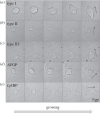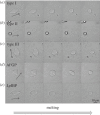New insights into ice growth and melting modifications by antifreeze proteins
- PMID: 22787007
- PMCID: PMC3481565
- DOI: 10.1098/rsif.2012.0388
New insights into ice growth and melting modifications by antifreeze proteins
Abstract
Antifreeze proteins (AFPs) evolved in many organisms, allowing them to survive in cold climates by controlling ice crystal growth. The specific interactions of AFPs with ice determine their potential applications in agriculture, food preservation and medicine. AFPs control the shapes of ice crystals in a manner characteristic of the particular AFP type. Moderately active AFPs cause the formation of elongated bipyramidal crystals, often with seemingly defined facets, while hyperactive AFPs produce more varied crystal shapes. These different morphologies are generally considered to be growth shapes. In a series of bright light and fluorescent microscopy observations of ice crystals in solutions containing different AFPs, we show that crystal shaping also occurs during melting. In particular, the characteristic ice shapes observed in solutions of most hyperactive AFPs are formed during melting. We relate these findings to the affinities of the hyperactive AFPs for the basal plane of ice. Our results demonstrate the relation between basal plane affinity and hyperactivity and show a clear difference in the ice-shaping mechanisms of most moderate and hyperactive AFPs. This study provides key aspects associated with the identification of hyperactive AFPs.
Figures







Similar articles
-
Ice-binding proteins that accumulate on different ice crystal planes produce distinct thermal hysteresis dynamics.J R Soc Interface. 2014 Sep 6;11(98):20140526. doi: 10.1098/rsif.2014.0526. J R Soc Interface. 2014. PMID: 25008081 Free PMC article.
-
Superheating of ice crystals in antifreeze protein solutions.Proc Natl Acad Sci U S A. 2010 Mar 23;107(12):5423-8. doi: 10.1073/pnas.0909456107. Epub 2010 Mar 9. Proc Natl Acad Sci U S A. 2010. PMID: 20215465 Free PMC article.
-
When are antifreeze proteins in solution essential for ice growth inhibition?Langmuir. 2015 Jun 2;31(21):5805-11. doi: 10.1021/acs.langmuir.5b00345. Epub 2015 May 18. Langmuir. 2015. PMID: 25946514
-
Antifreeze Proteins and Their Practical Utilization in Industry, Medicine, and Agriculture.Biomolecules. 2020 Dec 9;10(12):1649. doi: 10.3390/biom10121649. Biomolecules. 2020. PMID: 33317024 Free PMC article. Review.
-
Antifreeze proteins enable plants to survive in freezing conditions.J Biosci. 2014 Dec;39(5):931-44. doi: 10.1007/s12038-014-9468-2. J Biosci. 2014. PMID: 25431421 Review.
Cited by
-
Ice-binding proteins and the applicability and limitations of the kinetic pinning model.Philos Trans A Math Phys Eng Sci. 2019 Jun 3;377(2146):20180391. doi: 10.1098/rsta.2018.0391. Philos Trans A Math Phys Eng Sci. 2019. PMID: 30982449 Free PMC article.
-
Growth suppression of ice crystal basal face in the presence of a moderate ice-binding protein does not confer hyperactivity.Proc Natl Acad Sci U S A. 2018 Jul 17;115(29):7479-7484. doi: 10.1073/pnas.1807461115. Epub 2018 Jul 2. Proc Natl Acad Sci U S A. 2018. PMID: 29967176 Free PMC article.
-
Blocking rapid ice crystal growth through nonbasal plane adsorption of antifreeze proteins.Proc Natl Acad Sci U S A. 2016 Apr 5;113(14):3740-5. doi: 10.1073/pnas.1524109113. Epub 2016 Mar 2. Proc Natl Acad Sci U S A. 2016. PMID: 26936953 Free PMC article.
-
Calcium-Binding Generates the Semi-Clathrate Waters on a Type II Antifreeze Protein to Adsorb onto an Ice Crystal Surface.Biomolecules. 2019 Apr 27;9(5):162. doi: 10.3390/biom9050162. Biomolecules. 2019. PMID: 31035615 Free PMC article.
-
Hydroxyl Group Separation Distances in Anti-Freeze Compounds and Their Effects on Ice Nucleation.Int J Mol Sci. 2020 Nov 11;21(22):8488. doi: 10.3390/ijms21228488. Int J Mol Sci. 2020. PMID: 33187297 Free PMC article.
References
-
- Raymond J. A., Fritsen C., Shen K. 2007. An ice-binding protein from an Antarctic sea ice bacterium. FEMS Microbiol. Ecol. 61, 214–22110.1111/j.1574-6941.2007.00345.x (doi:10.1111/j.1574-6941.2007.00345.x) - DOI - DOI - PubMed
-
- Clarke C. J., Buckley S. L., Lindner N. 2002. Ice structuring proteins: a new name for antifreeze proteins. Cryo Lett. 23, 89–92 - PubMed
-
- Fletcher G. L., Hew C. L., Davies P. L. 2001. Antifreeze proteins of teleost fishes. Annu. Rev. Physiol. 63, 359–39010.1146/annurev.physiol.63.1.359 (doi:10.1146/annurev.physiol.63.1.359) - DOI - DOI - PubMed
-
- Duman J. G. 2001. Antifreeze and ice nucleator proteins in terrestrial arthropods. Annu. Rev. Physiol. 63, 327–35710.1146/annurev.physiol.63.1.327 (doi:10.1146/annurev.physiol.63.1.327) - DOI - DOI - PubMed
-
- Yeh Y., Feeney R. E. 1996. Antifreeze proteins: structures and mechanisms of function. Chem. Rev. 96, 601–61810.1021/cr950260c (doi:10.1021/cr950260c) - DOI - DOI - PubMed
Publication types
MeSH terms
Substances
Grants and funding
LinkOut - more resources
Full Text Sources

